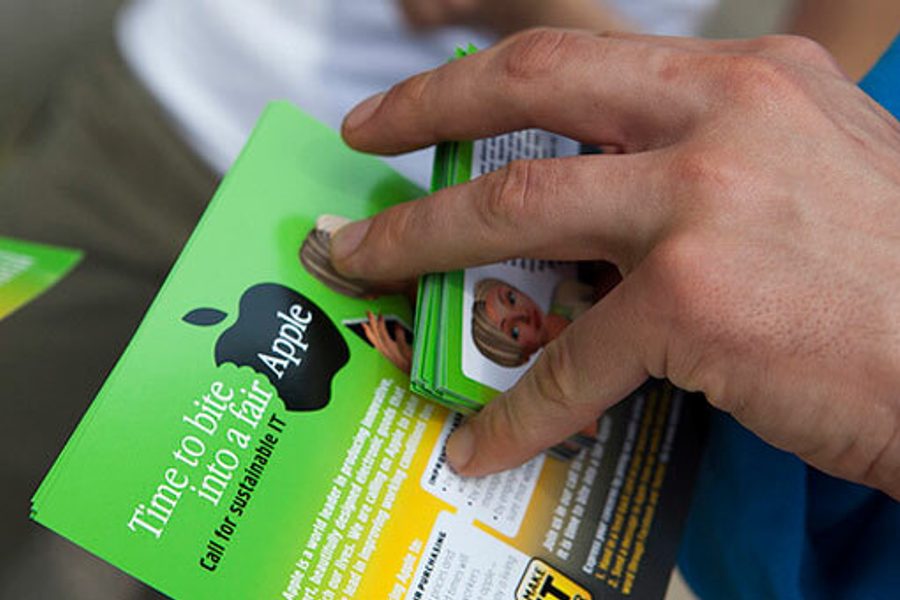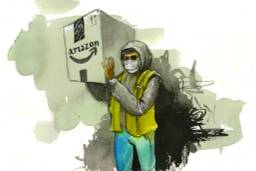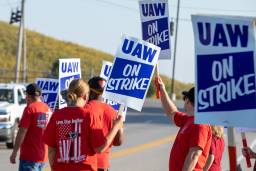
Apple’s brand glared in the media spotlight this past week, after the public learned that performance artist Mike Daisey’s theatrical rendering of the struggles of Apple factory workers contained false claims — painfully exposed on an episode of the radio program This American Life. But if one fundamental truth has emerged from the scandal surrounding Daisey’s dramatic fudging, it’s that the lived reality of many Chinese workers is undoubtedly bleak — no embellishment needed.
Daisey’s personal account is gratuitously peppered with fabrications, but the story of systematic exploitation is essentially true. For years various watchdog groups have tried to hold Apple accountable for harsh working conditions in China, which have been linked to workplace-related suicides and health hazards. Since a number of young workers killed themselves in 2010, the consumer advocacy campaign Make IT Fair, together with the Hong Kong-based Students Against Corporate Misbehavior (SACOM), have documented systematic abuses: exhausting hours, an oppressive, militaristic workplace culture and, despite conciliatory pay hikes, extremely low wages in comparison to the tremendous corporate profits and brutal working conditions.
It should be noted, however, that Daisey’s “dramatic license” was debunked largely through the real findings of intrepid investigations by advocates and professional reporters, which some commentators have highlighted amid the media fallout. As part of its “Retraction” episode, in fact, TAL interviewed New York Times reporter Charles Duhigg about the real story behind Daisey’s fictions.
On the reported widespread violations of a 60-hour weekly cap on working hours, Duhigg tells host Ira Glass, Apple claims workers volunteer for this excess work:
Duhigg: They say, “Look, one of the reasons why there is so much overtime that’s inappropriate and, in some places, is illegal, is because the workers themselves are demanding that overtime.”
Now, workers don’t always say that. What workers often say is that they feel coerced into doing overtime, that if they didn’t do overtime when it’s asked of them, that they wouldn’t get any overtime at all, and that financially they would suffer as a result.
This is the kind of more nuanced, day-to-day exploitation that Foxconn workers face – not so sensational, but nonetheless driven by global economic forces.
Li Qiang, head of the New York-based China Labor Watch, told In These Times that in terms of the situations Daisey described, basically, “What he said about working conditions is true.” He added, “Through this kind of media reporting, maybe more artists or journalists, or others will go to China to investigate the real circumstances in Chinese factories…. This way, this issue can generate more public debate.”
While Apple has touted a new partnership with the third-party monitoring organization Fair Labor Association, many critics remain wary that Apple will continue to fail the workers at the dregs of the supply chain. Even worse, Apple might turn the scandal into a marketing opportunity, polishing its reputation with a dab of “corporate social responsibility” measures.
Make IT Fair recently denounced the FLA partnership as “a mere PR stunt,” citing comments by FLA president Auret van Heerden praising Apple facilities as “way, way above the average of the norm.” Activists call on Apple and other industry leaders to adopt more stringent ethical codes, which protect the environment from damaging extraction of raw materials, honor collective bargaining rights, and protect workers and their communities from discrimination and rights abuses.
Apple’s real attitude toward its workers has been far from charitable. In a statement responding to TAL’s retraction, SACOM (whose campaigns have informed both Daisey’s and TAL’s reporting) pointed to the ongoing ramificiations of an incident that inspired Daisey’s narrative — a mass poisoning at a facility where workers were exposed to the chemical n-hexane while polishing gleaming touchscreens:
In contrast to Apple’s statement that they have all been treated successfully, many workers still suffer from weak limbs and other health problems after nine-month hospitalizations. The victims sent three letters to Apple last year, but the company did not answer them at all. Likewise, after the explosion at the iPad case manufacturer Riteng in Shanghai in last December, which injured 59 workers, Apple has not sent anyone to visit the victims. The young workers are in despair because their faces were disfigured due to the fire from the blast. Some of them suffer from bones so severely shattered that they may be permanently disabled. Three months have passed, but the victims have not received any compensation….
While Apple hypocritically expressed that the company was deeply saddened by the tragedy, it has never apologized or offered compensation to the workers for its negligence in complying with work safety rules.
For all his professed empathy for Foxconn workers, Daisey’s exaggerations were stupefyingly self-serving. Even as he awkwardly attempted to express contrition in the follow-up dialogue with Ira Glass, he insisted that within the realm of theater, he had legitimately blended fiction and nonfiction to create a more emotive experience for a Western audience.
The claim reveals that Daisey lied to elevate his role in the story. He basically decided that the ugly truth wasn’t quite dramatic enough for him — a sideways insult to the workers whose cause he claimed to champion.
In a correspondence with In These Times, SACOM project officer Chan Sze Wan said, “we worry that the public will misunderstand [and think] Foxconn is innocent after the Mike Daisey’s case.” As a research-based group, she added, SACOM “will continue to provide accurate information to consumers to solicit their supports,” but ultimately, voices of workers themselves will need to be heard:
Nowadays, Foxconn workers do not have real worker representative system in the factory. So, SACOM has to channel their grievances to Apple. However, we always emphasize that workers should be the ones to monitor the working conditions at their workplace and fight for the rights.
Following the string of suicides, a quote from a Chinese blog captured the workers’ story more eloquently than an American performer ever could:
Perhaps for the Foxconn employees and employees like us
– we who are called nongmingong, rural migrant workers, in China –
the use of death is simply to testify that we were ever alive at all,
and that while we lived, we had only despair.
In the context of that hushed plea, the media hooplah over the fudged Foxconn narrative simply distracts us from the real masterwork of fiction that Apple and other tech giants continue to peddle: the imaginary world of our gadgets, a cosmopolitan universe that pretends to connect everyone while in fact sharpening the lines between consumers and the invisible workers that enable that carefree lifestyle. And we’re all buying it.

I hope you found this article important. Before you leave, I want to ask you to consider supporting our work with a donation. In These Times needs readers like you to help sustain our mission. We don’t depend on—or want—corporate advertising or deep-pocketed billionaires to fund our journalism. We’re supported by you, the reader, so we can focus on covering the issues that matter most to the progressive movement without fear or compromise.
Our work isn’t hidden behind a paywall because of people like you who support our journalism. We want to keep it that way. If you value the work we do and the movements we cover, please consider donating to In These Times.
Michelle Chen is a contributing writer at In These Times and The Nation, a contributing editor at Dissent and a co-producer of the “Belabored” podcast. She studies history at the CUNY Graduate Center. She tweets at @meeshellchen.







